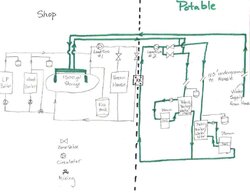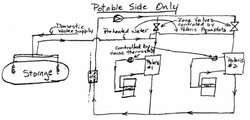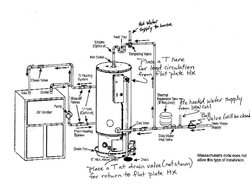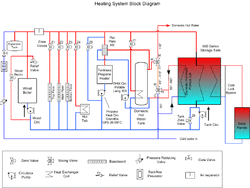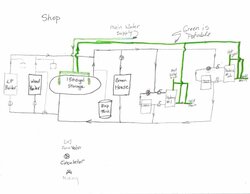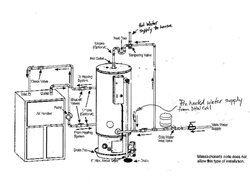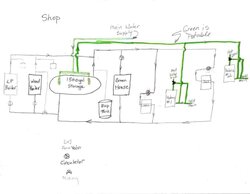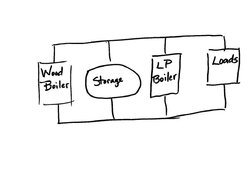Ok. I'm going to try one more time to to make my current system work with a wood hydronic system.
I have an unusual situation in that my existing heating system, while it is hydronic, uses potable hot water as the heating medium (as it also supplies the drinking hot water needs of the house). This system uses what are essentially very high output water heaters (both, 100k btu) in which the potable water is circulated through heating coils in two air handling plenums controlled by two separtate thermostats (in effect two separate zones).
Ideally I would like to keep my current system intact...including the use of potable water.
About a year ago, I asked this same question to those on this forum and was told to use shell and tube heat exchangers. However, I really don't think shell and tube exchangers are practical in this application due to the fact that in order to supply the btu demands of these units, the size and cost of the exchanger would be prohibitive. I suppose I am not too stubborn to be convinced that this is still the way I need to go, but it just doesn't seem right to me.
I had recently given up the idea of using potable water in the coils and was given valuable assistance by Eliot who helped me up my system with non-potable water. Although I may still have to go with that method, I thought I would give one more shot at presenting the knowledgeable individuals on this forum with an idea that I have in adapting nofossil's "Simplest Pressurized Storage System Design" to the system that I already have AND also maintain the use of potable water.
I know in some ways that a non-pressurized storage tank would be better suited to my set up, but I have located a very inexpensive 1500 gallon propane tank that I would really like to use.
A couple of my concerns on this design is the fact that I will have mineral buildup in the flat plate heat exchanger (which will be remedied by regular cleaning) and I am also concerned that a single flat plate and exchanger with 1.25" ports will support the volume of water and BTUs that will need to be pushed through it. Would two exchangers set up in parallel work better?
Please look at the attached design and give me your thoughts.
I have an unusual situation in that my existing heating system, while it is hydronic, uses potable hot water as the heating medium (as it also supplies the drinking hot water needs of the house). This system uses what are essentially very high output water heaters (both, 100k btu) in which the potable water is circulated through heating coils in two air handling plenums controlled by two separtate thermostats (in effect two separate zones).
Ideally I would like to keep my current system intact...including the use of potable water.
About a year ago, I asked this same question to those on this forum and was told to use shell and tube heat exchangers. However, I really don't think shell and tube exchangers are practical in this application due to the fact that in order to supply the btu demands of these units, the size and cost of the exchanger would be prohibitive. I suppose I am not too stubborn to be convinced that this is still the way I need to go, but it just doesn't seem right to me.
I had recently given up the idea of using potable water in the coils and was given valuable assistance by Eliot who helped me up my system with non-potable water. Although I may still have to go with that method, I thought I would give one more shot at presenting the knowledgeable individuals on this forum with an idea that I have in adapting nofossil's "Simplest Pressurized Storage System Design" to the system that I already have AND also maintain the use of potable water.
I know in some ways that a non-pressurized storage tank would be better suited to my set up, but I have located a very inexpensive 1500 gallon propane tank that I would really like to use.
A couple of my concerns on this design is the fact that I will have mineral buildup in the flat plate heat exchanger (which will be remedied by regular cleaning) and I am also concerned that a single flat plate and exchanger with 1.25" ports will support the volume of water and BTUs that will need to be pushed through it. Would two exchangers set up in parallel work better?
Please look at the attached design and give me your thoughts.


